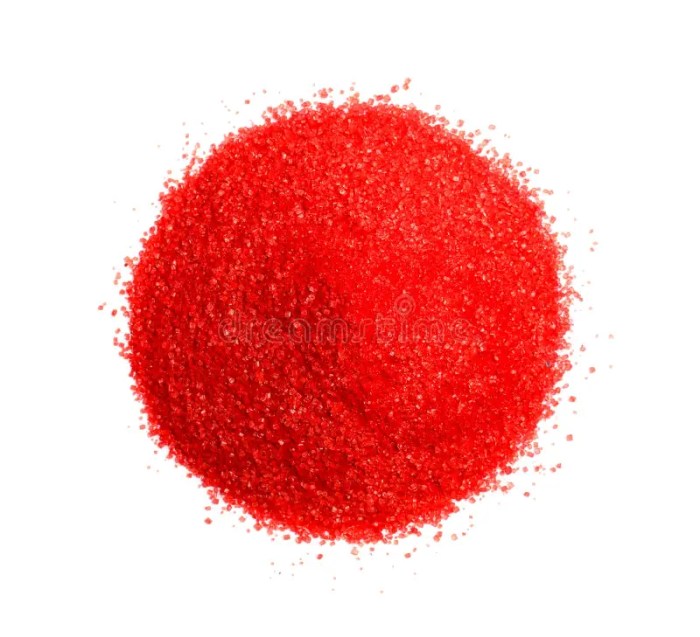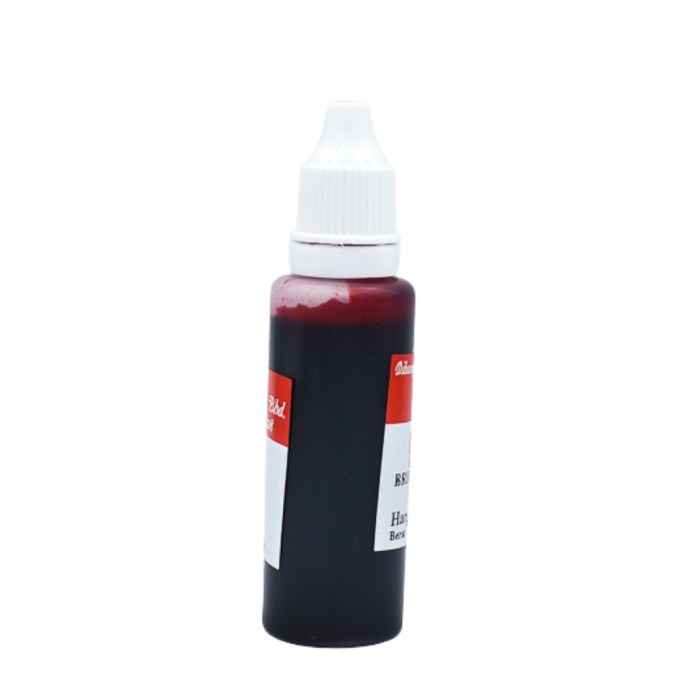Manufacturing Process of Bright Red Food Coloring

The production of bright red food coloring, often derived from natural or synthetic sources, is a complex process involving several stages, from sourcing raw materials to rigorous quality control checks ensuring safety and consistency. Understanding this process is crucial for consumers concerned about the origin and safety of the food they consume.
The specific steps involved in manufacturing bright red food coloring can vary depending on the source material (e.g., natural pigments like carminic acid from cochineal insects, or synthetic dyes like Allura Red AC). However, a general overview can be provided illustrating the common principles involved.
Raw Material Sourcing and Preparation
The process begins with the sourcing of raw materials. For natural colorants like carminic acid, this involves harvesting cochineal insects, carefully drying them, and extracting the carminic acid through a process involving water and acid. Synthetic dyes, on the other hand, begin with the synthesis of the specific chemical compound in a controlled laboratory environment, following precise chemical reactions.
Purity and quality of the raw materials are paramount at this stage; thorough testing is carried out to ensure they meet the required specifications.
Extraction and Purification
Once the raw materials are acquired, the next step is extraction and purification. For natural colorants, this often involves several stages of filtration, centrifugation, and potentially chromatography to isolate and purify the desired pigment. Synthetic dyes typically undergo recrystallization and other purification techniques to remove impurities and achieve a high degree of purity. The goal is to obtain a concentrated solution or powder of the desired bright red pigment.
Formulation and Standardization
After purification, the bright red pigment is formulated into a usable food coloring product. This involves mixing the pigment with specific carriers (e.g., water, propylene glycol) and stabilizers to improve its solubility, shelf life, and color stability in different food applications. The formulation is carefully adjusted to achieve the desired shade and intensity of red. This stage also includes adding any necessary preservatives to prevent microbial growth.
Standardization ensures that each batch of food coloring meets the same quality specifications.
Quality Control Measures
Stringent quality control measures are implemented throughout the entire manufacturing process. This includes regular testing of raw materials, intermediate products, and the final product to ensure purity, strength, and safety. Tests include checking for heavy metals, microbial contamination, and the presence of any unwanted substances. Each batch is assigned a unique identification number for traceability. Compliance with regulatory standards is meticulously documented and verified.
Packaging and Distribution, Bright red food coloring
Once the quality control checks are completed, the bright red food coloring is packaged according to industry standards. This typically involves filling the product into appropriate containers (e.g., bottles, sachets), labeling with the necessary information (e.g., ingredients, usage instructions, batch number), and distributing it to food manufacturers and other users.
Regulatory Standards and Compliance
The production of bright red food coloring is strictly regulated by governmental agencies such as the FDA (in the United States) and the EFSA (in Europe). These agencies establish standards for purity, safety, and labeling. Manufacturers must comply with these regulations, which include obtaining approvals for the use of specific dyes and conducting toxicity tests to ensure the safety of the food coloring for human consumption.
Regular audits and inspections are carried out by regulatory bodies to ensure compliance.
Ah, bright red food coloring – the culinary equivalent of a superhero cape for your cupcakes. But before you embark on a vibrant culinary adventure, one might ponder the existential question: if one were to add this potent hue to water, is imbibing such a concoction advisable? The answer, my friend, can be found by consulting this surprisingly informative resource on can you drink water with food coloring.
Ultimately, the decision of whether to transform your water into a crimson elixir rests solely with you – proceed with caution, and perhaps a straw.
Manufacturing Process Flow Chart
The following bullet points illustrate the key steps in the manufacturing process of bright red food coloring, highlighting the sequential nature of the operation.
- Sourcing and preparation of raw materials (natural or synthetic).
- Extraction and purification of the bright red pigment.
- Formulation and standardization of the food coloring product.
- Quality control testing at various stages of the process.
- Packaging and labeling of the final product.
- Distribution to food manufacturers and consumers.
Uses of Bright Red Food Coloring in Various Industries

Bright red food coloring, a vibrant and widely used pigment, finds its application across numerous sectors, impacting our daily lives in diverse and often unseen ways. Its intense color makes it a valuable tool for enhancing the visual appeal of products, but its uses extend far beyond mere aesthetics. Understanding these applications reveals the significant role this seemingly simple ingredient plays in our modern world.
Applications in the Food and Beverage Industry
Bright red food coloring is ubiquitous in the food and beverage industry, contributing significantly to the visual appeal and brand recognition of countless products. Its use ranges from enhancing the color of processed meats like sausages and bologna to adding vibrancy to candies, jellies, and soft drinks. The intensity of the color allows for even small amounts to create a noticeable effect, making it a cost-effective choice for manufacturers.
For example, the characteristic red of strawberry yogurt or the deep crimson of cherry pie filling often owes its intensity to the addition of this coloring. Variations in shade and intensity allow manufacturers to precisely match the color expected by consumers for different products.
Applications in Cosmetics and Pharmaceuticals
Beyond the food industry, bright red food coloring finds applications in cosmetics and pharmaceuticals, although often under stricter regulatory guidelines. In cosmetics, it can contribute to the color of lipsticks, nail polishes, and other beauty products. However, the specific types of red dyes used and their concentrations are carefully controlled to ensure safety for skin contact. Similarly, in the pharmaceutical industry, it might be used as a colorant in certain medications, particularly those in syrup or tablet form, to enhance their visual appeal and aid in product identification.
Again, strict regulations govern its use to ensure patient safety and product efficacy.
Geographical and Cultural Variations in Usage
The use of bright red food coloring shows some regional and cultural variations. In some cultures, bright red is associated with celebration and festivity, leading to its more prevalent use in celebratory foods and candies. Other cultures may have different color preferences, resulting in a less prominent use of bright red compared to other colorings. For example, while bright red might be commonly found in candies in North America, other regions might favor different color palettes in their confectionery.
These variations reflect the diverse cultural perceptions and culinary traditions around the world. Regulatory differences across regions also influence the types and amounts of red food coloring permitted in various products.
Table of Applications Across Industries
| Industry | Specific Application | Examples | Regulatory Considerations |
|---|---|---|---|
| Food & Beverage | Color Enhancement | Candies, Soft Drinks, Processed Meats | FDA regulations (USA), EFSA regulations (EU) |
| Cosmetics | Colorant in Makeup | Lipsticks, Nail Polish | Cosmetic safety regulations |
| Pharmaceuticals | Colorant in Medications | Syrups, Tablets | Pharmaceutical regulations |
| Other | Various Applications | Textiles (dyeing), Arts & Crafts | Industry-specific regulations |
Visual Aspects and Psychological Effects of Bright Red Food Coloring
Bright red food coloring, in its various shades, significantly impacts the visual appeal and perceived taste of food products, influencing consumer behavior and preferences through its powerful psychological effects. Its strategic use in branding and marketing is crucial for food companies aiming to capture consumer attention and drive sales.
Bright Red’s Influence on Visual Appeal
The color bright red possesses inherent qualities that enhance the visual attractiveness of food. Its vibrancy immediately draws the eye, making products stand out on shelves amidst a sea of other items. In applications like candies, jellies, and sauces, the intense color suggests sweetness and richness, stimulating appetite even before tasting. Subtle variations in shade—from a deep crimson to a lighter, more scarlet red—can alter the perceived texture and flavor profile.
A deep crimson might suggest a rich, dense consistency, while a lighter scarlet could indicate a lighter, more refreshing product.
Psychological Effects on Appetite and Preferences
Bright red’s effect extends beyond mere visual appeal; it triggers powerful psychological responses linked to appetite and preferences. Red is often associated with excitement, energy, and passion, all emotions that can positively influence consumer perception of food. Studies have shown that exposure to red can increase heart rate and stimulate appetite, making consumers more likely to purchase and consume red-colored products.
This effect is particularly pronounced in cultures where red symbolizes good fortune or prosperity. However, overuse can lead to negative associations, with some consumers perceiving it as artificial or overly processed.
Emotional Responses Evoked by Different Shades of Red
The specific shade of red used can significantly impact the emotional response it elicits. A deep, rich crimson evokes feelings of luxury, sophistication, and intensity, often associated with premium or high-quality products. A brighter, more scarlet red creates a sense of energy, fun, and youthfulness, often used for products targeting younger demographics. A more muted, pinkish-red shade can convey gentleness and sweetness, ideal for products aimed at children or those seeking a milder flavor profile.
The careful selection of red’s shade is a crucial aspect of effective product design.
Bright Red in Food Branding and Marketing
Food manufacturers leverage the psychological power of bright red extensively in branding and marketing strategies. The color often features prominently in logos, packaging, and advertising campaigns to create a memorable and impactful brand identity. For instance, a bright red logo can instantly convey a sense of energy and excitement, while red packaging can help products stand out on shelves.
This strategic use of color helps build brand recognition, attract consumers, and ultimately drive sales. The effectiveness of this strategy is evident in the widespread use of red in the branding of numerous successful food and beverage companies.
FAQ Section
What are the common side effects of consuming bright red food coloring?
While generally considered safe in approved amounts, some individuals may experience allergic reactions such as hives or digestive upset. More research is needed to fully understand the long-term effects of consuming artificial food colors.
Are there natural alternatives to bright red food coloring?
Yes, natural alternatives include extracts from beetroot, paprika, and annatto seeds, although they may not achieve the same intense shade of red.
How is the purity of bright red food coloring ensured?
Strict quality control measures are implemented throughout the manufacturing process, including testing for heavy metals and other contaminants. Regulatory bodies also set purity standards that manufacturers must meet.
Can bright red food coloring be used in homemade products?
Yes, commercially available bright red food coloring is suitable for use in homemade food and beverages, though it’s crucial to follow usage instructions and adhere to safety guidelines.
